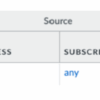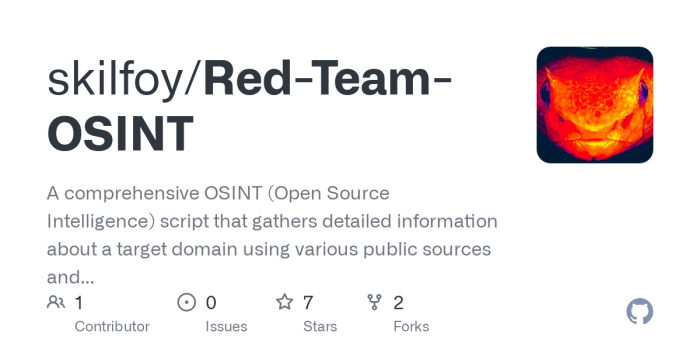Open source active reconnaissance red team strategies provide a fascinating look into leveraging publicly available information for penetration testing. This involves meticulous research and analysis of open-source data to identify vulnerabilities and potential attack vectors. Understanding the legal and ethical implications of active reconnaissance using OSINT is paramount, along with a detailed methodology for incorporating these findings into a broader red team engagement.
We’ll explore a variety of tools, techniques, and case studies, demonstrating how to effectively utilize OSINT for targeted attacks.
The process encompasses defining OSINT methods, analyzing tools and techniques, and integrating reconnaissance into red team methodology. This includes crucial aspects such as data analysis, reporting, and advanced techniques like social media analysis and honeypot usage. Real-world case studies showcase the practical application of these strategies, providing valuable insights into the effectiveness of open-source reconnaissance in red team exercises.
Defining Open Source Active Reconnaissance: Open Source Active Reconnaissance Red Team

Open-source active reconnaissance, a crucial component of red teaming, involves leveraging publicly available data to gather intelligence about a target. This process goes beyond passive observation, actively engaging with online resources to extract specific information. Understanding the methods, legal considerations, and ethical implications of this approach is vital for responsible and effective red team operations.This exploration delves into the specifics of open-source active reconnaissance, emphasizing the distinctions between passive and active techniques, and outlining the ethical and legal boundaries within which these methods must operate.
It also examines the rich tapestry of publicly accessible data sources that red teams can utilize for their exercises, and the potential legal pitfalls inherent in various OSINT methods.
Open-Source Intelligence (OSINT) Methods
Open-source intelligence methods form the bedrock of active reconnaissance. These methods encompass a wide array of techniques for gathering information, ranging from social media analysis to website scraping. They often involve interacting with websites, databases, and online platforms to extract relevant data. By actively engaging with these sources, red teams can build a more comprehensive understanding of the target.
Open source active reconnaissance red teams are fascinating, especially when you consider the diverse datasets they can leverage. For instance, finding high-quality images like those from the Samsung Galaxy S7 Active, specifically samsung galaxy s7 active photos , can provide valuable contextual clues for reconnaissance exercises. This type of data, when combined with other open-source intelligence, can reveal surprising insights, making these red teams a powerful tool for security professionals.
Legal and Ethical Considerations
Active reconnaissance using publicly available data must adhere to strict legal and ethical boundaries. Unauthorized access to systems, data breaches, or impersonation are strictly prohibited. Respecting intellectual property rights and privacy are paramount. Operating within the bounds of the law is crucial to avoid legal ramifications and maintain ethical conduct.
Passive vs. Active Reconnaissance
Passive reconnaissance involves observing publicly available data without directly interacting with it. Active reconnaissance, on the other hand, actively engages with the target, generating responses and gathering information based on those interactions. Understanding this distinction is essential to comprehending the potential legal and ethical ramifications of each approach. Active reconnaissance typically requires greater caution and meticulous adherence to legal guidelines.
Publicly Available Data Sources
Numerous publicly available data sources provide valuable insights for red team exercises. These include social media platforms (LinkedIn, Twitter), company websites, news articles, and government databases. Utilizing these resources judiciously and ethically allows red teams to gain a deeper understanding of their target environment. Comprehensive analysis of these sources can uncover valuable information about personnel, infrastructure, and potential vulnerabilities.
Ethical Implications of OSINT Techniques
The ethical implications of various OSINT techniques differ significantly. Some techniques may pose minimal risk, while others carry substantial potential legal pitfalls.
| OSINT Technique | Ethical Implications | Potential Legal Pitfalls |
|---|---|---|
| Social Media Monitoring | Potentially low risk if used ethically and responsibly, but may raise privacy concerns | Misinterpretation of information, invasion of privacy, defamation if used irresponsibly |
| Website Scraping | Generally permissible, but potential issues with terms of service violations | Violation of terms of service, data scraping restrictions, legal action by website owners |
| Public Records Searches | Generally permissible, but privacy and data usage limitations exist | Violation of privacy laws, misuse of personal information, inappropriate data sharing |
| Open-Source Code Analysis | Potentially low risk if used ethically, but copyright concerns | Copyright infringement, unauthorized use of code, misrepresentation of findings |
Active Reconnaissance Tools and Techniques
Active reconnaissance is a crucial phase in the red team’s arsenal, enabling them to gather detailed information about a target system or network without direct interaction. It involves actively probing the target, generating responses, and analyzing the results to gain a comprehensive understanding of its structure, vulnerabilities, and services. This process often employs a variety of open-source tools and techniques, each with specific strengths and limitations.
Understanding these tools and their capabilities is vital for effective red teaming.
Popular Open-Source Reconnaissance Tools
Several open-source tools provide valuable capabilities for active reconnaissance. These tools range from basic network scanners to sophisticated vulnerability assessment platforms. Each tool offers unique functionalities, addressing different aspects of the reconnaissance process. Choosing the right tool depends on the specific objectives and the nature of the target.
- Nmap: A powerful and versatile network scanning tool, Nmap can discover hosts, identify open ports, and determine the services running on those ports. Its extensive command-line options allow for fine-grained control over the scanning process, enabling customization for specific target environments. Nmap is widely used due to its speed, accuracy, and detailed output. However, Nmap’s output can be extensive and requires some analysis to extract relevant information.
- Nessus (community edition): Nessus offers a comprehensive vulnerability scanning platform. While its paid version provides more advanced features, the community edition offers a valuable set of tools to identify potential vulnerabilities in the target network. Its ability to detect outdated software and misconfigurations is essential for understanding a target’s security posture. A limitation is that the free edition may not provide real-time updates of the vulnerability database.
- Nikto: Nikto is a web server scanner that identifies potential vulnerabilities and misconfigurations on web servers. It quickly scans a website for known vulnerabilities and provides a report on the identified issues. Its primary focus is web-based security, making it a crucial tool for web application reconnaissance. Limitations include the potential for false positives, requiring manual verification of results.
Comparing OSINT Techniques
Various OSINT techniques provide different avenues for gathering information. Understanding their respective strengths and weaknesses is crucial for tailoring a reconnaissance strategy to specific needs. Comparing these techniques can help optimize the process and extract the maximum value from each.
- Web scraping: This technique involves automatically extracting data from websites. It can be used to gather information on publicly available company data, such as employee lists or contact information. Its effectiveness depends on the target website’s structure and the availability of the desired data. Web scraping can be a time-consuming process and requires expertise in programming languages like Python.
- Social engineering: This method focuses on manipulating individuals to obtain information or gain access to systems. It can be particularly effective when combined with other OSINT techniques. It’s a powerful tool, but its ethical implications must be carefully considered, and it carries a significant risk of legal consequences.
- Network scanning: This technique involves probing a network to identify active hosts, open ports, and running services. It’s a vital part of active reconnaissance, providing insights into the target network’s infrastructure. Its limitations include the potential for detection by intrusion detection systems and the difficulty in analyzing large networks.
Tools for Network Mapping, Vulnerability Scanning, and Service Discovery
Numerous open-source tools are available to facilitate network mapping, vulnerability scanning, and service discovery. Each tool offers a specific approach and set of features, and selecting the appropriate tool depends on the target’s characteristics.
- OpenVAS: Open Vulnerability Assessment System (OpenVAS) is a comprehensive framework for vulnerability scanning, providing a detailed report on potential weaknesses in the target system. It’s particularly valuable for large-scale network assessments.
- Zmap: Zmap is a fast network mapper that discovers and characterizes open ports on the internet. It’s highly effective for wide-area network discovery, and its speed makes it suitable for large-scale reconnaissance efforts. It has limitations in identifying services and detailed information about the identified hosts.
- Shodan: Shodan is a search engine for devices connected to the internet, allowing for the discovery of publicly exposed devices and services. It provides valuable insights into the target’s network infrastructure and potential vulnerabilities.
Tool Use Cases and Limitations
| Tool | Use Cases | Limitations |
|---|---|---|
| Nmap | Host discovery, port scanning, service identification | Requires technical expertise, can be resource-intensive for large networks |
| Nessus (community) | Vulnerability scanning, outdated software detection | Limited vulnerability database compared to paid versions, potential for false positives |
| Nikto | Web server vulnerability scanning | Relies on known vulnerabilities, potential for false positives |
| OpenVAS | Comprehensive vulnerability assessment, detailed reports | Can be resource-intensive, requires setup and configuration |
| Zmap | Fast network mapping, wide-area discovery | Limited service identification, less detailed information about hosts |
| Shodan | Discovery of publicly exposed devices and services | Limited to publicly exposed information, requires manual verification |
Red Team Methodology Integration
Open-source intelligence (OSINT) is no longer a niche activity; it’s a fundamental component of modern red team operations. Effective red teams leverage OSINT throughout the entire engagement lifecycle, transforming passive data collection into actionable insights for exploiting vulnerabilities and assessing the adversary’s posture. This integration significantly enhances the efficiency and effectiveness of red team activities, leading to more realistic and impactful assessments.
OSINT’s Role in Red Team Stages
OSINT is a crucial element in every stage of a red team engagement. It provides the foundation for understanding the target environment, identifying potential attack vectors, and building a comprehensive threat model. From initial reconnaissance to final reporting, OSINT informs every decision and action.
Open source active reconnaissance red teams are a fascinating area of cybersecurity. They leverage publicly available information to identify vulnerabilities in systems, and while researching these tools, I stumbled upon the Belkin USB-C Duratek cable belkin usb c duratek cable. Interestingly, this cable’s durability could potentially inspire similar robust design principles for the open-source tools themselves, ultimately bolstering the effectiveness of the reconnaissance process.
Stages of a Red Team Engagement and OSINT Activities
Understanding the target’s infrastructure, personnel, and processes is paramount. OSINT provides the intelligence needed to model the adversary’s posture and identify vulnerabilities. A well-defined OSINT strategy tailored to the specific target is essential for a successful red team engagement.
- Reconnaissance: In this phase, OSINT is paramount for gathering information about the target organization. This includes identifying publicly available information on the company’s website, social media presence, employee profiles, and news articles. This initial reconnaissance allows red team members to build a preliminary understanding of the target’s structure, security posture, and potential vulnerabilities. Detailed reports and analysis of the discovered information are created for subsequent steps.
- Threat Modeling: OSINT plays a crucial role in constructing a comprehensive threat model. Analysis of publicly available information reveals potential attack vectors, such as known vulnerabilities in used software, security policies, and employee practices. This detailed threat model, based on OSINT, guides subsequent activities and helps identify the most promising avenues for attack.
- Vulnerability Identification: OSINT provides critical inputs for identifying vulnerabilities. For example, examining publicly available documentation, security advisories, and open-source projects can reveal vulnerabilities in software or configurations. This information can be used to tailor exploitation attempts and craft more effective attacks. OSINT enables red teams to prioritize vulnerabilities based on their exploitability and impact.
- Exploitation: OSINT-derived information can aid in exploitation. Understanding the target’s network architecture, software versions, and security measures, obtained through OSINT, helps in the selection of effective exploits and attack vectors. This tailored approach, informed by OSINT, increases the likelihood of successful exploitation attempts.
- Reporting: OSINT data is essential for generating accurate and comprehensive reports. The findings from the OSINT activities are summarized and presented alongside other collected data, providing valuable insights into the target’s security posture. Detailed reports document the process, highlighting the OSINT findings and their influence on the engagement outcomes.
Tailoring an OSINT Strategy
A tailored OSINT strategy for a specific target is crucial for maximizing the effectiveness of red team activities. It needs to be customized to the target organization’s characteristics, including its size, industry, and known security practices. The scope and depth of the OSINT activities must align with the overall objectives of the engagement. Examples include focusing on specific technologies, employee profiles, and publicly accessible data relevant to the target’s industry.
| Stage of Red Team Engagement | Specific OSINT Activities |
|---|---|
| Reconnaissance | Web scraping, social media monitoring, domain name research, public records searches |
| Threat Modeling | Vulnerability analysis, threat intelligence aggregation, security policy analysis, infrastructure mapping |
| Vulnerability Identification | Code review, open-source vulnerability databases, security advisories analysis |
| Exploitation | Network reconnaissance, service enumeration, vulnerability exploitation |
| Reporting | Summarizing findings, documenting process, presenting insights on security posture |
Open Source Data Analysis and Reporting
Analyzing open-source intelligence (OSINT) data effectively is crucial for a red team’s success. This involves more than just collecting information; it requires meticulous extraction, insightful interpretation, and a structured approach to reporting. Effective analysis allows for a deeper understanding of target systems, vulnerabilities, and potential attack vectors.Interpreting the vast sea of publicly available data necessitates a systematic approach.
This includes defining clear objectives, developing a standardized methodology for data extraction and validation, and establishing a consistent framework for reporting. This process ensures that valuable insights are not lost amidst the noise.
Extracting and Structuring Data from Multiple Open Sources
Gathering OSINT involves accessing various platforms like social media, news articles, company websites, and public records. A crucial step is to develop a structured approach for collecting and organizing this information. This process should include automated tools to scrape data from different sources, while also using manual verification to ensure accuracy.A well-defined methodology for data extraction includes using a combination of web scraping tools, API integrations, and manual research.
This approach helps maintain a structured database, facilitating easy access to the collected data. For instance, a script could be developed to collect all publicly available information from a company’s website, including press releases, job postings, and security advisories.
Interpreting Collected Data for Insights
Interpreting collected data for insights requires a keen eye for patterns and anomalies. This involves identifying potential vulnerabilities, understanding the target’s security posture, and recognizing indicators of compromise (IOCs). By examining the data holistically, a red team can gain a comprehensive understanding of the target environment.For instance, if multiple social media posts reveal a lack of security awareness among employees, a red team might infer a potential vulnerability to social engineering attacks.
Similarly, if a company website lacks up-to-date security patches, it could indicate an opportunity for exploiting known vulnerabilities.
Prioritizing Open-Source Information
Prioritizing OSINT information is crucial for focusing efforts on the most promising leads. This process involves evaluating the reliability of sources, the relevance of information to the target, and the potential impact of identified vulnerabilities. Establishing clear criteria for prioritizing information will save time and resources, ensuring the team focuses on the most impactful data.A simple scoring system could be employed, assigning points based on source reliability, information age, and potential exploitability.
This ensures a clear, measurable way to prioritize the data.
Formats for Presenting OSINT Findings
Various formats can effectively present OSINT findings. These include traditional reports, dashboards, and interactive visualizations.
| Format | Description | Visualization Examples |
|---|---|---|
| Traditional Report | Comprehensive report detailing findings, analysis, and recommendations. | Bullet points, tables, numbered lists. |
| Dashboards | Visual representation of key OSINT findings, allowing for real-time monitoring. | Charts, graphs, maps. |
| Interactive Visualizations | Dynamic representation of data, enabling users to explore findings further. | Interactive maps, timelines, network diagrams. |
Creating Concise and Actionable Reports
A crucial aspect of OSINT analysis is creating reports that are concise, actionable, and easily understandable by stakeholders. The report should clearly communicate the findings, analysis, and any recommendations.A structured report template should include sections for:
- Executive Summary: A brief overview of the findings and recommendations.
- Target Overview: Details about the target organization and its operations.
- Data Sources and Methodology: Information about the sources used and the methods for analysis.
- Analysis and Findings: Detailed analysis of the gathered data and any insights identified.
- Vulnerability Assessment: Identification of potential vulnerabilities and their associated risks.
- Recommendations: Specific actionable steps based on the analysis.
Advanced Open Source Reconnaissance Techniques

Unveiling the hidden layers of information available through open sources is crucial for a comprehensive red team assessment. Beyond basic web scraping and social engineering reconnaissance, advanced techniques leverage specialized tools and insights to uncover sensitive data and potential vulnerabilities. This exploration delves into refined OSINT strategies, including social media mining, threat intelligence feeds, public record analysis, and the strategic deployment of honeypots.
Open source active reconnaissance red teams are fascinating, especially when you consider the talented individuals behind them. For instance, the folks behind the mineblast physics-based platformer, a game I’ve been checking out, are the same people who created the popular Super Cat Tales Android game. This week’s news on mineblast highlights the creativity and technical skills of this team, and it’s inspiring to see how that translates into open source active reconnaissance red team efforts.
Social Media Analysis for Threat Intelligence
Social media platforms are treasure troves of information, often revealing crucial details about individuals and organizations. Analyzing these platforms can provide insights into employee turnover, project updates, and even internal communication patterns. Tools designed for social listening can track conversations, identify key personnel, and monitor discussions relevant to the target. This proactive approach can illuminate vulnerabilities and potential attack vectors.
Threat intelligence feeds, often available through subscription services, provide real-time updates on emerging threats, vulnerabilities, and attack patterns. Integrating these feeds into the reconnaissance process enables a proactive approach to identifying potential risks before they materialize.
Public Records and Domain Name Registration Data
Public records, including court documents, property records, and corporate filings, can offer invaluable insights into a target’s operations and financial standing. Domain name registration data provides details about ownership, contact information, and the history of a website. Analyzing this data can reveal hidden connections, affiliations, and potential weaknesses. These sources, often overlooked in basic reconnaissance, can provide a more comprehensive understanding of the target’s infrastructure and personnel.
Specialized Tools and Techniques for Sensitive Data Identification
Identifying sensitive data or hidden information requires specific tools and techniques. Specialized search engines and data mining tools can uncover hidden files, leaked documents, or compromised data sets. Advanced techniques like reverse image search can connect seemingly disparate pieces of information, leading to a more comprehensive understanding of the target. For instance, a leaked document from one organization might indirectly reference a competitor’s internal system, providing a potential entry point for further reconnaissance.
Leveraging Honeypots for Enhanced Reconnaissance
Honeypots are decoy systems designed to attract attackers and gather information about their tactics and techniques. Setting up a honeypot within the scope of your OSINT campaign can reveal valuable insights into vulnerabilities and potential entry points. By monitoring interactions with the honeypot, you can gather valuable data on attack patterns, malware used, and the sophistication of the attackers.
This proactive approach allows for better threat modeling and vulnerability assessment.
Exploiting Open-Source Data for Vulnerability Identification
Open-source data can be used to identify and exploit vulnerabilities in a target system. Analyzing publicly available information about a target’s software versions, configurations, and security practices can reveal misconfigurations or known vulnerabilities. For instance, outdated software packages can have known exploits, allowing an attacker to gain access to the system. By identifying these weaknesses, red teams can create more effective attack strategies, focusing on exploiting weaknesses instead of brute-forcing access.
Real-World Case Studies
Open-source intelligence (OSINT) is increasingly crucial in modern red team engagements. Its ability to unearth valuable information about target organizations, often without raising suspicion, makes it a powerful tool for gaining initial access and identifying vulnerabilities. This section details real-world examples showcasing the effectiveness of OSINT in red team operations.
Successful Red Team Engagements Leveraging OSINT, Open source active reconnaissance red team
OSINT played a pivotal role in several successful red team engagements. These engagements highlight the various ways OSINT can be utilized to gain a competitive advantage, from reconnaissance to attack planning.
Initial Access Through OSINT
Gathering information from public sources like social media, company websites, and news articles can reveal crucial details about target organizations’ employees, security procedures, and even potential vulnerabilities. For example, a red team might discover an employee’s LinkedIn profile detailing a vulnerability in the target organization’s internal network, potentially leading to unauthorized access. Similarly, a carelessly worded public statement could reveal a security oversight.
Identifying Weaknesses and Misconfigurations
Analyzing publicly available information can uncover misconfigurations in target systems. For instance, outdated software versions, lack of security patches, or improperly configured firewalls might be identified through OSINT research. This information allows red teams to craft targeted attacks against these vulnerabilities.
Crafting Effective Attack Plans Using OSINT
Thorough OSINT research provides insights into the target organization’s structure, processes, and potential attack vectors. Analyzing company websites, documentation, and employee profiles can help red teams identify potential weak points in the organization’s security posture, leading to the development of more effective and tailored attack plans. This includes determining the most likely points of entry and possible avenues for escalating privileges.
Table of Real-World OSINT Effectiveness
| Engagement | OSINT Discovery | Vulnerability | Impact |
|---|---|---|---|
| Target: Acme Corporation | Employee LinkedIn profile revealing outdated VPN configuration | Unpatched VPN vulnerability | Successful initial access to internal network. |
| Target: Beta Solutions | Publicly available conference presentation detailing insecure API access | Insecure API endpoint | Compromised sensitive data. |
| Target: Gamma Technologies | Company website displaying outdated server software | Vulnerable server software | Successful exploitation of the vulnerability leading to unauthorized access. |
| Target: Delta Industries | Social media posts revealing employee password reuse patterns | Brute-force vulnerability | Compromised accounts and access to sensitive data. |
Ending Remarks
In conclusion, open-source active reconnaissance provides a powerful toolkit for red teams. The ethical and legal considerations surrounding the use of publicly available data are critical to understanding the implications of these activities. Effective strategies, combined with careful planning and analysis, enable red teams to uncover valuable vulnerabilities and demonstrate potential attack surfaces. By understanding the intricacies of open-source reconnaissance, red teams can significantly enhance their effectiveness in identifying and mitigating threats.






